I have my user struct with has a dictionary of all their social medias.
struct User: Identifiable {
var id: String { uid }
let uid, email, name, bio, profileImageUrl: String
let numSocials, followers, following: Int
var socials: [String: String]
init(data: [String: Any]) {
self.uid = data["uid"] as? String ?? ""
self.email = data["email"] as? String ?? ""
self.name = data["name"] as? String ?? ""
self.bio = data["bio"] as? String ?? ""
self.profileImageUrl = data["profileImageURL"] as? String ?? ""
self.numSocials = data["numsocials"] as? Int ?? 0
self.followers = data["followers"] as? Int ?? 0
self.following = data["following"] as? Int ?? 0
self.socials = data["socials"] as? [String: String] ?? [:]
}
}
The idea is for socials (the dictionary), to be dynamic, since users can add and remove social medias. Firestore looks like this:
The dictionary is initialized as empty. I have been able to add elements to the dictionary with this function:
private func addToStorage(selectedMedia: String, username: String) -> Bool {
if username == "" {
return false
}
guard let uid = FirebaseManager.shared.auth.currentUser?.uid else {
print("couldnt get uid")
return false
}
FirebaseManager.shared.firestore.collection("users").document(uid).setData([ "socials": [selectedMedia:username] ], merge: true)
print("yoo")
return true
}
However I can't seem to read the firestore map into my swiftui dictionary. I want to do this so that I can do a ForEach loop and list all of them. If the map is empty then the list would be empty too, but I can't figure it out.
Just in case, here is my viewmodel.
class MainViewModel: ObservableObject {
@Published var errorMessage = ""
@Published var user: User?
init() {
DispatchQueue.main.async {
self.isUserCurrentlyLoggedOut = FirebaseManager.shared.auth.currentUser?.uid == nil
}
fetchCurrentUser()
}
func fetchCurrentUser() {
guard let uid = FirebaseManager.shared.auth.currentUser?.uid else {
self.errorMessage = "Could not find firebase uid"
print("FAILED TO FIND UID")
return
}
FirebaseManager.shared.firestore.collection("users").document(uid).getDocument { snapshot, error in
if let error = error {
self.errorMessage = "failed to fetch current user: \(error)"
print("failed to fetch current user: \(error)")
return
}
guard let data = snapshot?.data() else {
print("no data found")
self.errorMessage = "No data found"
return
}
self.user = .init(data: data)
}
}
}
TLDR: I can't figure out how to get my firestore map as a swiftui dictionary. Whenever I try to access my user's dictionary, the following error appears. If I force unwrap it crashes during runtime. I tried to coalesce with "??" but I don't know how to make it be the type it wants.
ForEach(vm.user?.socials.sorted(by: >) ?? [String:String], id: \.key) { key, value in
linkDisplay(social: key, handler: value)
.listRowSeparator(.hidden)
}.onDelete(perform: delete)
Please be patient. I have been looking for answers through SO and elsewhere for a long time. This is all new to me. Thanks in advance.
